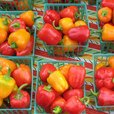 It seems that it’s become the “in thing” to say “I’m going Green” and purchase only organic, cage-free, natural, certified humane, free range, grass-fed, blah, blah, blah and blah type foods. Now, I’m a foodie just like the next person, but I also realize where and how my food is processed and makes it from the field to my plate and I can say that many folks today are very disconnected from their food.
It seems that it’s become the “in thing” to say “I’m going Green” and purchase only organic, cage-free, natural, certified humane, free range, grass-fed, blah, blah, blah and blah type foods. Now, I’m a foodie just like the next person, but I also realize where and how my food is processed and makes it from the field to my plate and I can say that many folks today are very disconnected from their food.
Coming from a farm I have the up most respect for the farmers that supply my table with food. So, when all these terms start showing up on food labels across the nation, it makes what should be a simple everyday choice very complicated.
I have to wonder if most of us really understand what the term “organic” means when it comes to the food we consume or what exactly is free-range poultry…
I work with organic producers around the state in my job with the Dept. of Agriculture and I help producers become certified organic through the USDA. I thought when I took this job a little over a year ago I knew exactly what it meant to be organic, but I’ve learned a lot since then.
I was very impressed that the Food Network has an entire section on its website that helps consumers understand what the term organic means and the differences in the growing and harvesting of organic foods, compared to conventionally grown food. If a product bears a "USDA organic" label, you are guaranteed that's it's at least 95 free of pesticides, synthetic fertilizers and sewage sludge and that it hasn't been genetically modified or irradiated. No hormones or antibiotics are allowed; animals must be fed organically-grown feed and have access to the outdoors. While some experts have suggested that organic foods are healthier than conventionally-grown, the USDA doesn't support these claims.
The site also has a list of ways to become eco-friendly which I really enjoyed reading. Here is the list from the site so you can make steps to "Go Green" in your home.
10 Eco-Friendly Tips
Shop Locally. Look for locally grown produce at farmers' markets, farm stands and food co-ops. You get fresher fare, support your community and help reduce fuel waste and emissions from long-distance shipping.









3 comments:
Great tips. There truly is a lot of confusion in food labeling. The Food Network's glossary of terms is a good start, but Animal Welfare Approved has a more extensive one, and it explains how what the animal eats affects you when you eat the meat, dairy or eggs from that animal. The website is (www.AnimalWelfareApproved.org), and you can just click on the link, "What do Food Labels Really Mean?"
Thanks for the great tip Jen!
You know people now are starting to grill more into winter, extending the grilling season, could be because of the Green Movement?
CMAC
Post a Comment